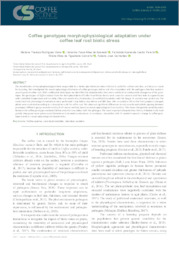Coffee genotypes morphophysiological adaptation under coffee leaf rust biotic stress.
Coffee genotypes morphophysiological adaptation under coffee leaf rust biotic stress.
Author(s): VIANA, M. T. R.; AZEVEDO, H. P. A. de; PEREIRA, F. A. C.; CARVALHO, M. A. de F.; GUIMARÃES, R. J.
Summary: The identification of morphophysiological traits responsible for a better plant behavior when infected is useful for cultivar selection, and become crucial for breeding. We investigated the morphophysiological behavior of coffee genotypes before and after inoculation with the pathogen Hemileia vastatrix, causal agent of coffee rust. With multivariate techniques we identified the characteristics that most contribute to total genetic divergence of the genotypes. Ten genotypes of Coffea arabica from the Germplasm Bank of Coffee from Minas Gerais were sown in a nursery and then take to a greenhouse with controlled temperature and humidity. After one month of acclimatization, the artificial inoculation with the fungus H. vastatrix was carried out. The anatomical and physiological evaluations were performed 1 day before inoculation and 160 days after inoculation. When the first symptom emerged, plants were evaluated according to a descriptive scale for coffee rust. We observed significant differences in rust severity and ostiole opening between genotypes. Different groups were formed by the K-means method, based on morphophysiological characteristics. This shows that genetic variability exists between the coffee genotypes evaluated before and after inoculation with the pathogen. The most important characteristics that contributed to the total genetic divergence were xylem vessel diameter and stomatal conductance. In conclusion, inoculation with H. vastatrix caused a change in coffee genotypes based on morphophysiological characteristics.
Publication year: 2021
Types of publication: Journal article
Unit: Embrapa Coffee
Keywords: Café, Coffea arabica var. arabica, Estresse biótico, Ferrugem, Folha, Genótipo, Morfologia Vegetal
Observation
Some of Embrapa's publications are published as ePub files. To read them, use or download one of the following free software options to your computer or mobile device. Android: Google Play Books; IOS: iBooks; Windows and Linux: Calibre.
Access other publications
Access the Agricultural Research Database (BDPA) to consult Embrapa's full library collection and records.
Visit Embrapa Bookstore to purchase books and other publications sold by Embrapa.

